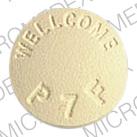Atovaquone Dosage
Medically reviewed by Drugs.com. Last updated on Apr 5, 2024.
Applies to the following strengths: 750 mg/5 mL
Usual Adult Dose for:
Usual Pediatric Dose for:
Additional dosage information:
Usual Adult Dose for Pneumocystis Pneumonia
750 mg orally twice a day for 21 days
Alternative therapy may be needed if arterial blood gas values do not improve or worsen after 7 to 10 days of therapy, or if the clinical status declines after 4 days.
Usual Adult Dose for Pneumocystis Pneumonia Prophylaxis
1500 mg orally once a day
Usual Adult Dose for Babesiosis
750 mg orally twice a day with azithromycin (500 to 600 mg on day 1, followed by 250 to 600 mg once a day thereafter or 1000 mg once a day for 3 days, followed by 500 mg once a day thereafter) for 7 to 10 days
Usual Adult Dose for Malaria
500 to 750 mg orally every 12 hours for 7 days; should be used in combination with other antimalarial agents
Usual Adult Dose for Toxoplasmosis
750 mg orally every 6 hours for 2 to 6 months
Similar doses given every 6 to 8 hours are used for toxoplasmosis maintenance therapy.
Atovaquone is considered second-line therapy for toxoplasmosis. It should be administered in combination with pyrimethamine and leucovorin, with sulfadiazine, or as a single agent in patients intolerant of pyrimethamine with sulfadiazine.
Usual Pediatric Dose for Pneumocystis Pneumonia
1 month to 12 years: 20 mg/kg orally twice a day
13 years or older: 750 mg orally twice a day for 21 days
Maximum dose: 1500 mg/day
Usual Pediatric Dose for Pneumocystis Pneumonia Prophylaxis
1 to 3 months: 30 mg/kg orally once a day
4 months up to 2 years: 45 mg/kg orally once a day
2 to 12 years: 30 mg/kg orally once a day
13 years or older: 1500 mg orally once a day
Maximum dose: 1500 mg/day
Usual Pediatric Dose for Babesiosis
1 to 12 years: 20 mg/kg orally twice a day with azithromycin (12 mg/kg once a day) for 7 to 10 days
13 years or older: 750 mg orally twice a day with azithromycin (500 to 600 mg on day 1, followed by 250 to 600 mg once a day thereafter or 1000 mg once a day for 3 days, followed by 500 mg once a day thereafter) for 7 to 10 days
Maximum dose: 1500 mg/day
Renal Dose Adjustments
No data available
Liver Dose Adjustments
Caution and monitoring are advised in patients with severe hepatic insufficiency.
Precautions
Atovaquone treatment failures, due to decreased absorption and inadequate serum levels, have occurred when patients take the drug on an empty stomach. If the patient cannot take atovaquone with meals, it is suggested that alternate treatment be initiated if possible. For similar reasons, atovaquone should be avoided in patients with diarrhea or malabsorption syndrome.
The efficacy of atovaquone has not been established in patients with severe Pneumocystis pneumonia or in patients who are not responding to sulfamethoxazole-trimethoprim therapy.
Rarely, hepatitis, elevated liver function tests, and at least one case of fatal liver failure have been reported with the use of atovaquone. However, causality could not be established due to many confounding medical conditions and concurrent drug treatments.
Caution and monitoring is advised in patients with severe hepatic impairment.
Safety and efficacy have not been established in pediatric patients.
Dialysis
No data available
Other Comments
Atovaquone should be administered with food or a high-fat meal.
More about atovaquone
- Check interactions
- Compare alternatives
- Pricing & coupons
- Reviews (6)
- Latest FDA alerts (3)
- Side effects
- During pregnancy
- Drug class: miscellaneous antibiotics
- Breastfeeding
- En español
Patient resources
Other brands
Professional resources
Other brands
Related treatment guides
Further information
Always consult your healthcare provider to ensure the information displayed on this page applies to your personal circumstances.


